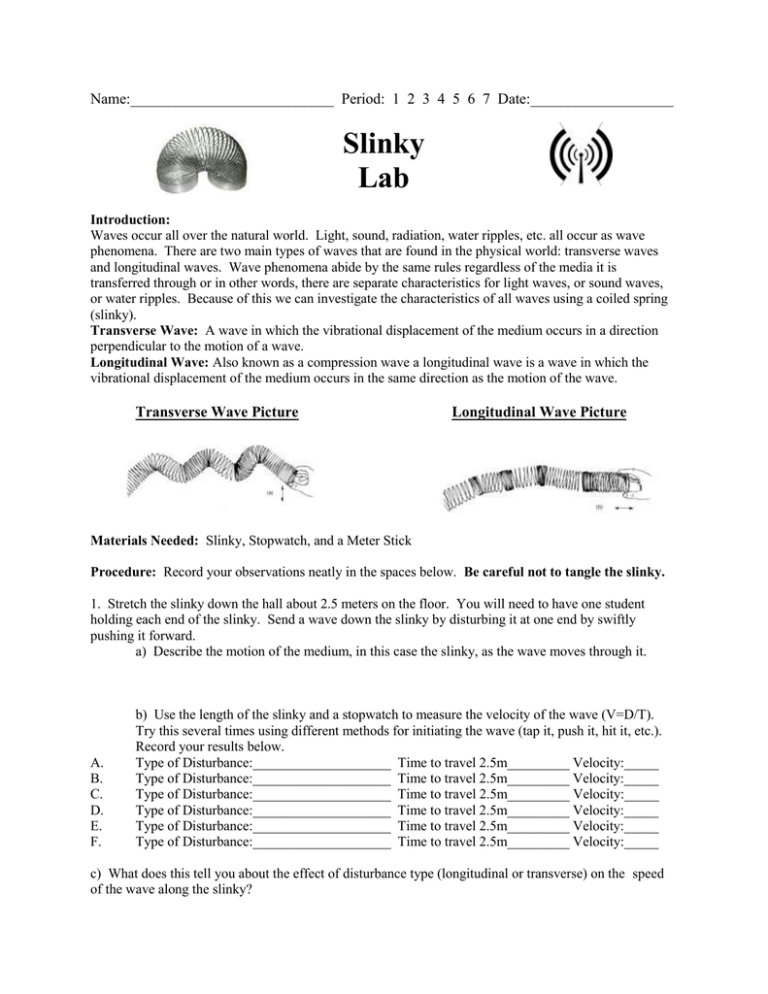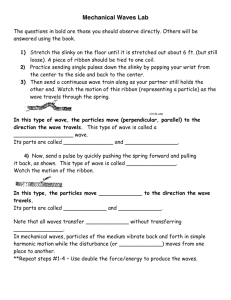Slinky Lab
advertisement

Name:___________________________ Period: 1 2 3 4 5 6 7 Date:___________________ Slinky Lab Introduction: Waves occur all over the natural world. Light, sound, radiation, water ripples, etc. all occur as wave phenomena. There are two main types of waves that are found in the physical world: transverse waves and longitudinal waves. Wave phenomena abide by the same rules regardless of the media it is transferred through or in other words, there are separate characteristics for light waves, or sound waves, or water ripples. Because of this we can investigate the characteristics of all waves using a coiled spring (slinky). Transverse Wave: A wave in which the vibrational displacement of the medium occurs in a direction perpendicular to the motion of a wave. Longitudinal Wave: Also known as a compression wave a longitudinal wave is a wave in which the vibrational displacement of the medium occurs in the same direction as the motion of the wave. Transverse Wave Picture Longitudinal Wave Picture Materials Needed: Slinky, Stopwatch, and a Meter Stick Procedure: Record your observations neatly in the spaces below. Be careful not to tangle the slinky. 1. Stretch the slinky down the hall about 2.5 meters on the floor. You will need to have one student holding each end of the slinky. Send a wave down the slinky by disturbing it at one end by swiftly pushing it forward. a) Describe the motion of the medium, in this case the slinky, as the wave moves through it. A. B. C. D. E. F. b) Use the length of the slinky and a stopwatch to measure the velocity of the wave (V=D/T). Try this several times using different methods for initiating the wave (tap it, push it, hit it, etc.). Record your results below. Type of Disturbance:____________________ Time to travel 2.5m_________ Velocity:_____ Type of Disturbance:____________________ Time to travel 2.5m_________ Velocity:_____ Type of Disturbance:____________________ Time to travel 2.5m_________ Velocity:_____ Type of Disturbance:____________________ Time to travel 2.5m_________ Velocity:_____ Type of Disturbance:____________________ Time to travel 2.5m_________ Velocity:_____ Type of Disturbance:____________________ Time to travel 2.5m_________ Velocity:_____ c) What does this tell you about the effect of disturbance type (longitudinal or transverse) on the speed of the wave along the slinky? 2. Create a longitudinal wave by creating a disturbance in a direction parallel to the direction of the wave motion. Describe what happens to the medium (slinky) as the wave travels from one end to the other. 3. Generate a transverse wave by moving your hand quickly to either the left or the right. Describe the motion of the medium as the wave moves through it. 4. Again, stretch the slinky so it is 2.5m long and create a transverse wave pulse. a) Record the time it takes to get to the other end. Repeat this several times changing the height (amplitude) of the wave each time and recording the time from one end of the slinky to the other. How does changing the amplitude of the wave affect how long it takes to get from one end to the other? b) Now try generating more than one wave. Slowly move your hand side to side at a constant rate. Describe what you see. c) Now move your hand side to side at a faster rate and describe what you see. Include in your description what happens to the speed, frequency and size (wavelength) of the wave. d) What conclusions can you draw about how changing the amplitude and frequency of the source affects the characteristics of a wave? 5. With one person on each end of the slinky, have each person create on transverse wave of about the same size with a disturbance in the same direction. Describe what happens when the disturbances meet along the medium and after they meet. Sketch a picture of what you see. 6. Now have each person create a transverse wave, but this time make the disturbances in opposite directions. Describe what happens when the disturbances meet along the medium and after they meet. Sketch a picture of what you see.





